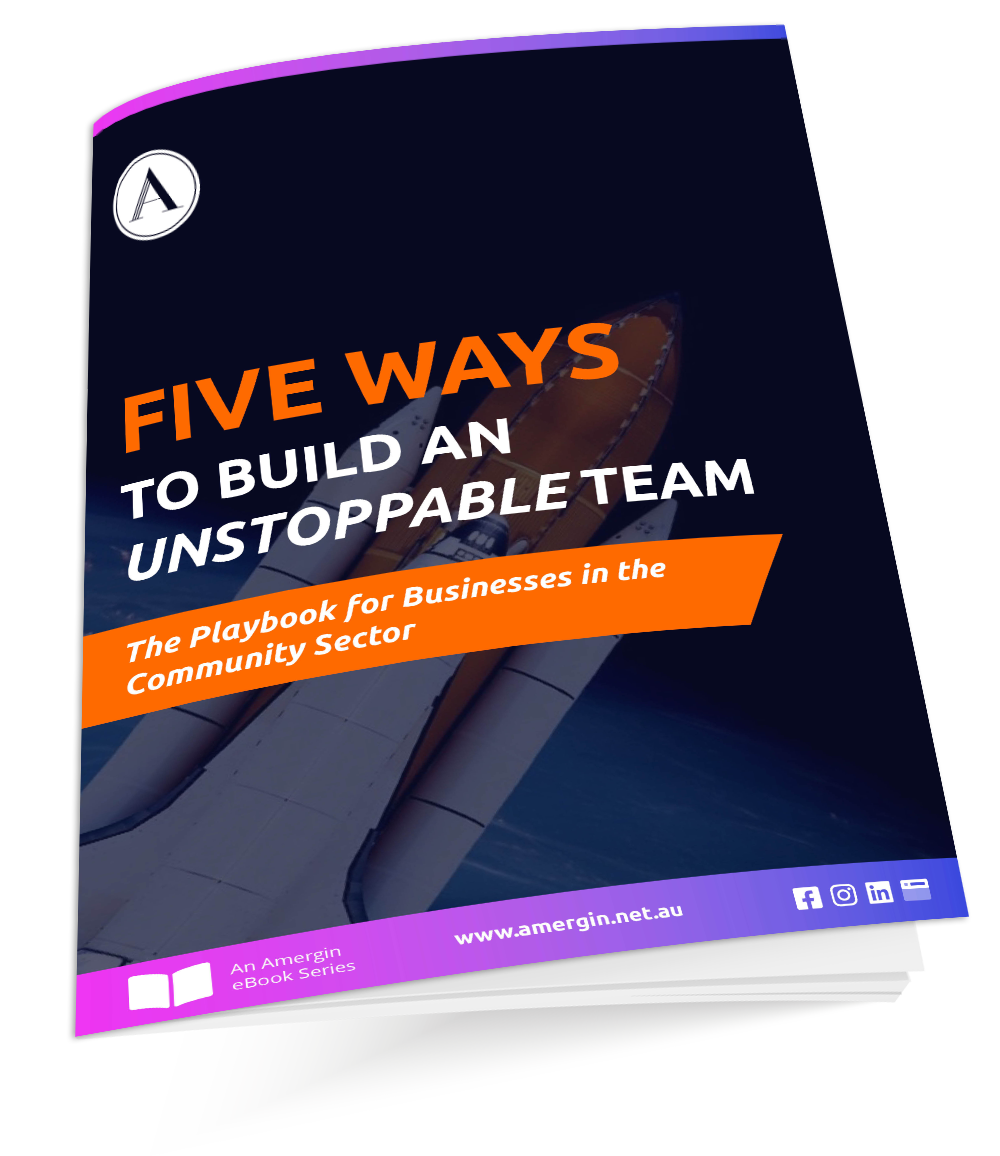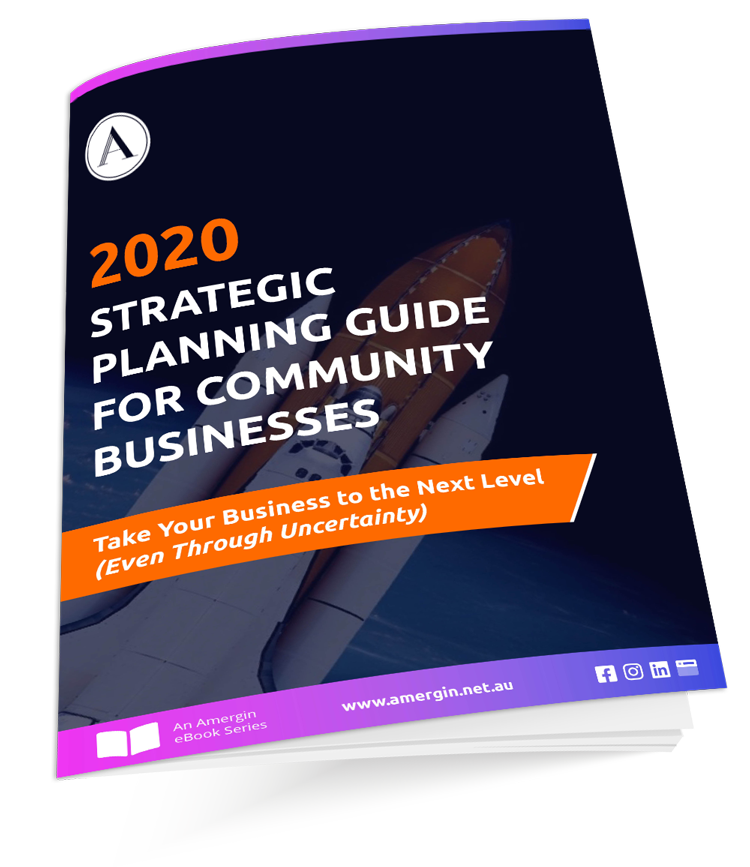The post Strategic and Operational Planning for 2022 and Beyond appeared first on Amergin.
]]>
What is your greatest business challenge? I’m not a mind reader (and far from it), but I’m confident you are thinking about an aspect of your business that is impacted by the COVID pandemic.
As Australia emerges from the latest lockdowns we are in the crosshairs of enormous challenges, but even greater possibilities! For example, the Australian Bureau of Statistics reported in June 2021 that 26% of businesses in the Healthcare and Social Service industry indicated they were having trouble finding suitable staff1. Given those statistics, are you comfortable providing your services with “unsuitable” staff? Or, with creative planning and strategic implementation, your company can be one that great staff will want to work with!
Success, triumph, and a sense of accomplishment require 3 things: a goal, an experience, and a measurable outcome. A Strategic and Operational Plan provides this structure for your business and your participants to succeed! In my 20 years of experience in social services, I’ve noticed very clearly that many businesses and services fail because of one thing…the failure to successfully implement great ideas with measurable outcomes. Don’t let this happen to you! Amergin wants to empower you to be impactful beyond your wildest dreams, by supporting you with your Strategic and Operational Plan, its implementation, and beyond.
Join our exclusive LIVE webinar: Strategic and Operational Planning for 2022 and Beyond and you will:
1Australian Bureau of Statistics, Business Conditions and Sentiments, June 2021, accessed 01/11/2021.
The post Strategic and Operational Planning for 2022 and Beyond appeared first on Amergin.
]]>The post Funding Available for Western Australian Businesses appeared first on Amergin.
]]>
Are you a small-to-medium (SME) business based in Western Australia? You might be entitled to government funding support of up to $20,000…
This funding forms part of the Industry Facilitation Scheme and is designed to enhance business capacity, capability and competitiveness to supply major projects and markets in Australia and overseas – this includes services within the NDIS and Aged Care markets.
The level of funding support under this round is 75% of eligible costs up to a maximum level of funding of $20,000 (excluding GST) per successful applicant – this means businesses must be prepared to front 25% of the total cost.
When do I need to apply by?
This round closes in January 2022.
If I am successful, how can Amergin help?
Our team are experts in compliance and can support you in the following ways:
Can Amergin help me complete the application itself?
Amergin is unable to help you complete the application form due to a conflict of interest between helping clients apply for the same grant.
Where can I find more information?
We encourage you to review the Guidelines as outlined in the National and International Standards Compliance Round.
The post Funding Available for Western Australian Businesses appeared first on Amergin.
]]>The post Mental Health First Aid and the NDIS – Does Your Workforce Have the Right Skills? appeared first on Amergin.
]]>
What impact can Mental Health First Aid have on NDIS providers, their staff and their participants?
Market analysis of NDIS growth trends continually identifies psychosocial disability supports as an area in need of significant development (and need for participant support).
With many providers stepping into this space, it’s important to be able to set yourself apart from the others and make your business a leading provider.
Speaking from experience, one of the biggest issues with finding the right provider ‘fit’ for psychosocial participants is the staff’s capability for supporting people who have challenging behaviours. This goes further than just the use of restrictive practices; more commonly the skillset needed is being able to understand and respond to unpredictable and fluctuating needs.
To do this well, staff need to be confident, capable, and adaptive. Time and time again it’s become apparent that these aren’t skills that come naturally to everyone, but thankfully they are skills that can be taught.
Being able to be a leading provider in this space means employing staff who have expert skills such as:
It’s not about having staff that knows absolutely everything, but it is about having staff that can do their specific job well. These skills come from experience, and they also come from knowing the best practice approaches and with staff feeling capable and confident each day when they come to work. In my experience, it’s when staff are scared or unsure that avoidable mistakes occur.
This is where professional development/training in Mental Health First Aid can fill that gap.
Mental Health First Aid (MHFA) teaches staff how to assist people who are developing a mental health problem, experiencing a worsening of an existing mental health problem, or in a mental health crisis, until appropriate professional help is received, or the crisis resolves.
MHFA training can be delivered in a tailored way that provides your staff with the necessary skill sets that will ensure they can support participants with psychosocial disability.
As a result, you and your staff will have:
About Kimberley
Having worked in the mental health and disability sector for over a decade, Kimberly has found a passion for educating and training workers to be able to better support those living with a psychosocial disability.
Throughout her career, she has coordinated services and supports for people who have complex needs due to their psychosocial disability. As a result, she has become adept at identifying providers who have a competent workforce and has learnt what to look for and what to avoid.
Kimberly has experience working with organisations to tailor evidence-based training to their staff to work either with specific participants or certain participant profiles, such as those who have challenging behaviours related to their Personality Disorders.
Kimberly is also a qualified Standard Mental Health First Aid instructor and has over half a decade’s experience delivering MHFA courses to NGOs, public health staff, and government agencies. Kimberly takes pride in being able to purposefully target content based on the trainees’ needs and area of work so it can be easily applied into their practice.
Current Offer
2-day community-based Mental Health First Aid courses from $150 per staff member, and private 2-day courses from $1000 per course*.
To register for a Mental Health First Aid course or to learn more about how you can provide the best service possible to your participants, Email Kimberly or phone her directly on 0405 560 937.
*Please note the fee structure differs for online course delivery.
The post Mental Health First Aid and the NDIS – Does Your Workforce Have the Right Skills? appeared first on Amergin.
]]>The post Re-entering the workforce as a new parent – 5 ways to put your oxygen mask on first! appeared first on Amergin.
]]>
I am a new mum. A FIRST-TIME new mum. I am 9 months post-partum and have the most beautiful son. I can’t say it has been the most beautiful experience though; we all have our story, and we all have our challenges.
The last 18 months have challenged many of us in a variety of ways.
As a first-time parent in the midst of a worldwide pandemic, most of our pregnancies and first few months with our newborns have been spent in isolation. Medical appointments were moved online, human interaction has been reduced along with the celebrations of the new life being developed, plus a constant fear, loneliness and anxiety plagued many of us. We have been forced to confront emotions and become comfortable with our own company.
During 2020 I was a Senior Manager of a newly established program, with shared responsibility of 50 staff members, across 16 sites, bordering 2 highly populated states. Now couple that with falling pregnant, COVID-19 hitting and a transition to a work-from-home environment. What a head spin!
As a result of the pandemic many community sector employees (myself included) were forced to take leave, reduce their hours or accept a redundancy. Employees were forced to take stock for the first time and review what was most important and find a balance physically, mentally, emotionally, and financially.
Since that time, I have had my son, leaned on my close supports, stepped well beyond my comfort zone and started to re-build my toolbox of ways to be a great first-time parent AND a staff member re-entering the workforce in this COVID-19 world.
Here are my top 5 ways to help others experiencing the same, or for employers to consider when supporting their first-time parents to re-enter the workforce:
1. Be selfish
We’ve all heard the saying that when the aircraft is going down, put on your oxygen mask first and then help others. I always understood the principle of this, but never thought I would be one to do it. Maybe its parent-guilt thinking this is selfish, but it is so vital. Being a parent is one part of me, not all of me.
For me – my oxygen mask is working part-time, it is my Sunday night routine where I can focus on getting myself into a work mindset, it is attending my Pilates class, and having enough downtime to reflect on who I am.
We’re often shown this narrative of self-care being a candlelit bath with a glass of wine, though as nice as this sounds the reality is this doesn’t work for everyone, we will all have that something which works for us.
2. Find out what is important to you
Birth complications, organisational restructures, being restricted from family and friend support – it is when you are faced with these lifechanging moments, all of a sudden, everything in your life is quickly put into perspective.
Deep self-reflection and considering the support of mental health professionals can allow you to see opportunities in often dismal situations or help you make decisions that will bring you one step closer to what is really important to you.
3. Be vulnerable, and ask for help
As staff members within a helping profession, we are often the last to consider asking for help ourselves.
This is something we can also bring into parenthood therefore it is so important to accept help but also know when to ask for it. Whether it be due to circumstances at home or your workload at the office, now is not the time to try and carry the load by yourself.
Seek professional supervision, mentoring or mental health support BEFORE you really need it. This benefits not only your own wellbeing but those around you and your employer.
4. Set boundaries and your non-negotiables
I have been fortunate to have many mentors and leaders who have looked out for my best interests, but there comes a point when you have to be your own advocate. This starts with finding a way to be comfortable with saying no. Easier said than done.
For me, part of this is seeing your own self-worth, and being confident in your own abilities. It also means saying yes to what works for you.
As a first-time parent re-entering the workforce you need to set your non-negotiables from the beginning and communicate these clearly and as early as possible to your employer. The right employer will respect these needs and be open to discussing what you need versus what the organization needs.
5. It’s ok to let go
Being comfortable with the uncomfortable – its tough!
Ask any parent whether they have 1 or 11 children, one of the hardest parts of being a parent is accepting that you can’t be everything for everyone, and that’s ok.
It is important to have discussions with your partner or supports about shared responsibilities, what works best in your family to share the load and what you are willing to accept (such as that growing pile of laundry).
The same applies in your work environment. There will be things you simply can not contribute to or squeeze into your day and with the right prioritisation strategies you can learn to let go and accept what might have to wait until tomorrow.
Supporting staff (especially first-time parents) to re-enter the workforce and navigate the many changes the pandemic has forced upon us needs specialised advice and education.
Next Steps
Contact Amergin today to find out how best we can support you and your employees during these challenging times to ensure the wellbeing of your staff and as a result the best outcomes for your clients.
The post Re-entering the workforce as a new parent – 5 ways to put your oxygen mask on first! appeared first on Amergin.
]]>The post Risk Assessments: What you need to know appeared first on Amergin.
]]>
Risk assessments are a hot topic at the moment, particularly in the NDIS, as auditors focus in on how providers are managing their risks. And their findings indicate there is quite a lot of room for improvement!
So why are risk assessments so important? Because it’s the law? Because the Standards or Quality Indicators say so? We all know that is partly the reason but mostly it is because doing a thorough and detailed risk assessment allows you to see areas of your business that may be exposed or could cause harm to others. This provides you with an opportunity to consider ways to reduce possible impacts if those situations were to happen; which can save you thousands of dollars, plenty of time, and may even prevent you losing your entire business. Not to mention preventing a lot of pain and anguish from injuries or illness that could have been avoided.
Over the last few years, I have observed many providers taking the time to understand and work with their clients to assess possible risks for them (as well as their home environment and in community settings). This has included documenting the risks and periodically reviewing them with their staff members, the client, and other stakeholders actively involved. And rightly so – client safety is fundamental to delivering any type of supports. It has also been refreshing to see that completing client risk assessments is becoming ‘the way we do things’, as opposed to ‘don’t forget to do that risk assessment thing!’
But what about other risks? How are you managing risks to your staff? And what about your organisation? When auditors are looking at how providers are managing risks, they are looking at 3 key areas:
As a provider, you have a responsibility to identify, assess and manage all of the above risk types.
Risk Assessments should include identifying what the potential risks might be, the current controls you have in place to prevent or minimise those risks, and what other actions you can put in place to further reduce the possible outcomes. Any follow-up actions should be allocated to a responsible person in the organisation (who has the appropriate authority to do so), to ensure the action is completed.
Here are my top 4 tips for completing risk assessments:
- Include your staff members, clients (where possible) and other stakeholders when conducting risk assessments. Not only is this part of health and safety law (employers must consult with employees), but it helps to create engagement and ownership over risk management processes. Getting everyone on-board with safety allows a team approach, not leaving responsibility to only a few individuals.
- Have a consistent approach to assessing risks. By using a risk matrix that is applied across the organisation, it allows management to prioritise what needs to be done and how quickly based on how high (or low) the risk scores are. There are several methods you can use, although a common way is to follow the AS ISO 31000:2018 Standards and I would recommend this.
- Make risk assessments a part of your processes and the usual way you do things. Just as client risk assessments have become an expected part of intake procedures, make organisational and staff risk assessments standard procedure. This could be as simple as allocating time as part of staff meetings and management meetings to discuss and review risk assessments or any concerns that have been raised in relation to risk (and documenting the outcomes).
- Don’t forget to review risk assessments when things change. It’s easy to think your risk assessments are complete once they are done, but they should be living documents and updated when things happen.
Now what about Dignity of Risk?
Becoming a more focussed topic within the community sector, respecting a client’s right to take risks falls within your risk assessment processes too. It is important for organisations and staff delivering services to understand the concepts of dignity of risk… but I’ll save that for another article 😊
Next Steps
Understanding how to assess, mitigate and manage risks within your organisation can be a minefield.
This is where Amergin can help.
Our experienced and qualified team can provide education and support to help you better understand how to identify and manage the risks within your organisation.
Contact one of our Social Impact Consultants to find out more today!
The post Risk Assessments: What you need to know appeared first on Amergin.
]]>The post Approved Aged Care Provider | The Top 5 Things to Consider When Engaging A Consultant For Your Aged Care Application appeared first on Amergin.
]]>
You’ve made the exciting decision to apply to become an approved Aged Care provider, congratulations!
It’s through your initial research however you’ve identified the need for support. We get it, the application process can be overwhelming, daunting, and time-consuming and it is at this point you start to consider the use of a consultant to support you.
At Amergin we speak with hundreds of organisations each year who are seeking help with just that. Often however many feel in the dark and unsure about how to select the best consulting business for their needs.
To help you make your decision, we have developed the following Top 5 things to consider when engaging an aged care consultant on your journey to applying to become an approved aged care provider:
1. Review the experience of their business
With an increase in consulting businesses across Australia, it is easy to feel overwhelmed by the variety of options to choose from. We recommend however that you request to speak with a high-level staff member about the business’ experience supporting organisations through the application process specifically. A business can have many years of operations however if it has not specifically been with aged care application support, they are unlikely to know how best to provide you with expert advice and guidance. Consider asking them about the number of organisations they have assisted, for how long, and the full extent of their experience with the process. What learnings have they adapted to their continuous improvement activities and approaches?
2. Review the experience and knowledge of their people
In addition to the above, it is important that you are not only matched with a dedicated consultant to guide you through the process, but that their aged care team has extensive experience with the application process and knowledge of the sector firsthand. Just because a consultant has knowledge and experience of the NDIS registration process does not mean they understand the aged care application process given the two are starkly different. When it comes to knowledge of the sector, throughout the application process you will be studying and looking to understand the aged care legislation and Standards and how to implement those into practice. This is where you need to be able to lean on your consultant for advice and to help transfer what they know from directly working in a provider (at a high level, not as a Support Worker).
3. Question the numbers
Any experienced consultancy business involved in supporting organisations through the application process will know just how challenging it can be given ultimately it is up to the Commission whether someone is approved or not. This is why it is important that consulting businesses are transparent in relation to their client success rates and outcomes from the applicants they have supported. From the data released by the Australian Government in relation to new Home Care Package approved providers each quarter, it would be highly unlikely for a consulting business to claim a 100% success rate…
4. Don’t be afraid to ask for references
Not only will it assist you to make your decision, but it can also lead to a beneficial working relationship for you to align with an organisation that has just been through the application process. Don’t be afraid to ask the consultancy business before signing any paperwork that you’d like to speak with at least 2 previous organisations they have supported in the past 6-12 months. If the business has had successful outcomes and built lasting positive relationships with these providers, they will have no problem with sharing that information. When speaking with the references make sure to ask not only about their experience through the process in general but importantly any areas, they feel the consultancy business could have improved.
5. Lastly, remember you get what you DON’T pay for
In life if it’s too good to be true, it usually is. The same applies to consultancy businesses. When comparing considerably different prices, do they all compare in relation to services offered? Do the products and resources they supply match up? Will you receive one-on-one support from your own dedicated consultant or a team? Just how many hours of support can you expect? Will your documents be templates or tailored specifically to your business? Are you comparing apples to oranges?
The application process is challenging enough which is why we want to make sure in partnering for support, you find the right match for your organisation’s needs.
At Amergin we take pride in making sure we are transparent, supportive, and provide consulting services with an education focus given ultimately you are in the driver’s seat once it’s time to operate.
The support we provide organisations approaching the aged care application process have been adapted over time based on direct feedback from the Commission and the extensive experience of our team.


To learn more about how we can support you in your journey to becoming an approved aged care provider (and to compare our apples) feel free to get in touch with our aged care team.
Aynsley and Jennifer are looking forward to speaking with you soon.
The post Approved Aged Care Provider | The Top 5 Things to Consider When Engaging A Consultant For Your Aged Care Application appeared first on Amergin.
]]>The post Technology and the Generational Gap in the Workplace appeared first on Amergin.
]]>
Today’s workplace is a very different place to what it was when I began my working career 45 years ago.
Being born in 1960, I’m a member of the demographically large generation born between the end of WWII and mid-1960s, known as Baby Boomers. The term ‘boomer’ is derived from the boom in births that took place after the return of soldiers from WWII.
Employers today are now leading workplaces which are more generationally diverse than at any other time in history. Having four generations in the workplace is going to require a level of dialogue, understanding and interaction between people that probably hasn’t happened before. Generational diversity, although facing some challenges, has great potential and presents many opportunities for staff to share their knowledge and experience.
Addressing the positives and challenges of the age-diverse workforce begins with an understanding of the priorities and needs of each generation. From Baby Boomers to Gen Xs to Gen Ys (or Millennials) to Gen Zs, each group brings a different view on careers, technology and life in general. Here’s a look at the 4 generations comprising the work force today.
What Are The Generational Differences?
Today, there are roughly four generations employed in the workforce:
- The Baby Boomer Generation born between 1946-1964
- Generation X born between 1965-1980
- Generation Y or Millennials born between 1980-2000
- Generation Z born between 1995-2015
A Step Back In Time – My Experience With Technology in the 70s Workplace
I was employed as a Stenographer. For many of you unfamiliar with the term, a Stenographer transcribes speech in shorthand used especially for taking dictation. Shorthand is a phonetic system where the symbols do not represent letters, but sounds. These sounds are then represented by strokes which differ only in thickness, the thin stroke representing “light” sounds, the thick stroke representing “heavy” sounds. Vowels were also represented with dots and dashes. Doing this required a specialist fountain pen with a very fine, but flexible nib. Writing with shorthand symbols allowed you to write at a quicker speed than traditional handwriting so speed and accuracy were essential. Shorthand was used widely in the office as recording and dictation machines were yet to be invented.
After taking dictation, the next step was to decipher the strokes, dots and dashes and, using a manual typewriter, type the letter or document back into longhand. We were trained to ‘touch type’ which meant you weren’t to look at the keys as you typed so that your focus was completely on your shorthand notebook.
The process for using a typewriter went as follows – manually set your margins, place a piece of paper behind the cylinder and roll the paper up using a dial at the side until the paper is where you need to start typing. Align the paper, then push back the paper lock and the paper release lever and start typing. When you finish typing a line, the typewriter would activate a bell to let you know it was time to return the carriage manually to its original position with the carriage-return lever, and you would then continue typing on to the next line.
When the type began to fade it was time to change the ribbon spools. The ribbon is what transfers the ink to the paper when you strike a key. The ribbon was threaded through the carrier. Once the ribbon carrier was raised, we had to be sure it was threaded correctly and the new spool put back in the same way. Some typewriter ribbons have two different coloured pigments (usually black and red) which could be selected if the typewriter had a switch to allow for words or sentences to be written in a different colour when required. Today we click Bold or Italics, or both and have a wide selection of font sizes and colours to choose from.
Typically, a typewriter had an array of keys, and each one caused a different single character to be produced on the paper. If you made a mistake while typing, you had to start again – there were no delete buttons on a typewriter.
Today, we take for granted that modern technology allows us to print unlimited copies of documents from our computers, however photocopiers weren’t a luxury in most 70s offices, so carbon copies of typewritten documents had to be made instead. When placed between an original and a second piece of paper to be copied onto, carbon paper would transfer marks made by the pressure applied by a typewriter making a clean, legible copy of the original.
Typewriters continued their dominance in the 70s albeit with improvements. For example, electrical typewriters made an introduction to the workplace in the late 70s and were designed to minimize noise in the office environment. When there were many stenographers working in one office, in what was called a typing pool, the noise could be deafening when all were typing at once. A cartridge was also used to replace the ink rather than ribbon and spools so this was a big step forward.
A telex machine was a must in most workplaces. The telex is essentially a large typewriter with a punch-tape unit. It operated entirely in upper case and, prior to transmission, a tape would be prepared and checked. It could then be transmitted automatically once the number had been dialled and the connection made. Telex was a major method of sending written messages electronically between businesses. Its usage went into decline as the fax machine grew in popularity in the 1980s.
The telephone also looked very different than today’s office phone systems. Our offices and desks were outfitted with rotary dial phones. Like the mobile today, everybody had one, and they ruled domestic and office communications. All that changed in the 1980s when they were replaced by the push button telephone.
Office design, furniture and technology have changed substantially to reflect ever-shifting economic and cultural changes through the decades, setting the stage for some of the most advanced products today.
The Digital Age
The relationship between technology and Boomers is vastly different in comparison to the newer generations, particularly now the ‘digital age’ has emerged. We’ve gone from rotary phones and telex machines being the height of office innovation, to instant messaging, video conferencing and the quest for a good wi-fi connection so you can work from the cosy coffee shop nearby. The introduction of computers has diminished the need for huge filing systems, duplicate copies and off-site file storage.
A common misconception of Boomers is that they lack understanding of and/or fail to effectively utilise technology however, the expansion of radio, television, mobile phones, personal computers and the Internet have all been pioneered by Boomers.
Today Gen X and Millennials (children of the Baby Boomers) aren’t just the future leaders of industry – they’re already running the show as Managers. Gen Z, born after 1995, are also entering the workforce en masse. These three generations, all digital natives, are already shaping the workplaces of the future.
Millennials have grown up in a time of rapid change, giving them a set of priorities and expectations sharply different from the Baby Boomers. They have come of age during a time of technological change which has given them a different set of behaviours and experiences than their parents. By the year 2000, the entrance of social medial allowed customers to articulate their satisfaction with companies and make decisions based on the company’s behaviour and not just on price alone. So at this point, companies also began to react and change.
Current digital systems such as computers, smartphones, tablets and laptops have evolved over time. The availability of the Internet provides us with ready access to information anytime, anywhere. Connectivity enables us to conduct our shopping and banking online. We can stay in touch and communicate instantly with friends and family anywhere in the world via social media.
Building An Inclusive Culture In The Workplace
Today, both Baby Boomers and Millennials have access to the same technology. However, the behaviour towards technology and its usage differs between the two generations. The Boomers for instance, use the technology to assist them with getting the information they need and increasing their convenience. The technology in the hand of the Millennials is being used mostly for connections. The older generation sees the social networking and mobile technology as ‘new technology’, whereas for Millennials, it is just the where and how of interaction. Recognition and self-expressions are some of the goals the Millennials also want to achieve through technology.
Because of the fast growth in the technological evolution, the Boomers only had the opportunity to grow up seeing it, whereas the Millennials grew up knowing it.
Generations will come and go. Once it was a world with Baby Boomers, today it is the Millennials and soon, the world will be taken over by the next generation. Technology on the other hand will always stay and always evolve. It will always evolve in the hands of the current generation, who will pass it on to the next generation and by this, the technological evolution will keep on changing the generation’s behaviour and workplace culture.
Even though Millennials have studied and naturally learned to thrive in this digital age, the Boomers did well for themselves long before technology monopolized the workplace. They hold a lot of knowledge and insight into important things that future generations need to understand. Not to mention that people learn better when they feel respected, as they are more enthused to listen and become educated on unfamiliar topics.
Organisations are a diverse place. Employees of different generations have diverse management preferences not only because they view the world differently, but also because they are usually at very different career stages. The pivotal Millennial group prefers their manager to act like a coach or mentor, while Baby Boomers prefer a dependable and consistent manager. Beyond that, Millennials and Baby Boomers can complement each other well in a work setting, filling in the gaps to create a diverse and accomplished team.
Respecting and understanding each other’s views and values will allow different generations to increase their appreciation of one another. Mutual respect for one another – in the workplace and life in general – should always be first and foremost.
Leadership is the driving force of workplace culture. Management sets the behaviour standards through their words and actions, along with policies and procedures. A business must pay attention to the presence of stereotypes in its organization if it is to be successful and retain its most productive, knowledgeable employees. This in turn, will lead to better communication and collaboration because employees are now talking from a sense of appreciation and acknowledgement.
Understanding and aligning with the values of these multi-generational employees helps to achieve the organisation’s goals. By recognising these values and then building a workplace experience that lives up to them, businesses will not only attract and retain the best talent that transcends generations, but also achieve their goals sooner. At the same time they will gain a competitive advantage by building a culture that their entire workforce will thrive in.
Where do I start?
If you want to get started on building an inclusive team that are engaged and productive, you can download our Free eBook – Five Ways to Build An Unstoppable Team
Just click the link and enter your email address and we’ll send it to your inbox.
If your staff are disengaged or underperforming, you’re battling a tense work environment culture or you’re struggling with poor customer service, it’s a sign you may be dealing with an unhealthy team.
The post Technology and the Generational Gap in the Workplace appeared first on Amergin.
]]>The post Why Your Team Culture is Eating Your Strategy for Breakfast appeared first on Amergin.
]]>
It’s no secret that without a business strategy, you don’t get results. Your strategy is your map to achieving your objectives and your vision. But here’s the thing – your team culture eats your strategy for breakfast.
Does that sound familiar? “Culture eats strategy for breakfast” was made famous by well-known management expert, Peter Drucker.
When you break it down, it means no matter how powerful your strategy is, its success relies on the people who deliver it.
When you have an engaged, high-performing team, your business thrives. Your team are aligned with the values and direction of your business and want to go the extra mile.
However, when your team is showing unhealthy signs, not only is your strategy impacted, so is your team morale, your client services and your bottom line.
The signs of an unhealthy team culture aren’t always obvious.
They can start off small – an under-performing team member isn’t making progress or poor client feedback is starting to become more regular. When you don’t have the right strategy to manage these, the problems can escalate.
There are five ways you can nip these issues in the bud and transform your team into a high-performing one.
To get started, download your free copy of our community sector playbook, Five ways to build an unstoppable team.
It will walk you through the mistakes to avoid and the changes you can start making today to build a high-performing team and accelerate results in your business.
And if like many businesses your strategy has taken a hit this year, or gone out the window, you can get your free 2020 Strategic Planning Guide to drive your business forward with certainty and clarity.
With a high performing team and a solid strategy, you’ll have a winning combo to charge into 2021 in full swing!
Where do I start?
If you want to get started on building a high performing team that are engaged and productive, you can download our Free eBook – Five Ways to Build An Unstoppable Team
Just click the link and enter your email address and we’ll send it to your inbox.
If your staff are disengaged or underperforming, you’re battling a tense work environment culture or you’re struggling with poor customer service, it’s a sign you may be dealing with an unhealthy team.
The post Why Your Team Culture is Eating Your Strategy for Breakfast appeared first on Amergin.
]]>The post NDIS Provider Insurance: Five Things You Need to Know appeared first on Amergin.
]]>
NDIS organisations across Australia work in a wide variety of settings and are exposed to a number of unique obligations and risks.
For providers operating in disability and/or aged care, it’s particularly important to be proactive in managing these risks. Yes, you need policies and procedures to govern your operations and great training to help your staff put these into practice.
Even with well-considered risk management strategies, there is the potential for all kinds of things to go wrong and sometimes unpredictable operating environments.
Here’s five reasons why NDIS Providers need insurance that not only protects their business but understand the environment they operate in.
5 Reasons for obtaining Good NDIS Provider Insurance
- Your service is fundamentally different than other business in terms of the services you offer, how you deliver them and ultimately the level of risk you face. It’s important your business insurance covers for what you need.
- The NDIS Quality and Safeguards Commission requires all Registered Providers to have a certain level of insurance including professional indemnity and public liability. You may need additional cover, particularly if you are providing services like complex clinical care.
- Insurance can protect you against a significant business disruption to your business. Should an unexpected event bring your business to a halt, you can stay on top of bills to keep things running.
- Mistakes or malpractice can happen even to the most vigilant providers. Failure to secure adequate insurance cover could lead to substantial financial penalties, lawsuits and even result in forced closure.
- Protection against cyber breaches. In administering disability services, a lot of personal and sensitive client data may be stored. This makes it essential to have excellent computer security practices and to comply with privacy legislation, as well as to have cyber liability cover in case of breaches.
To help our clients manage their insurance needs, Amergin (through amerginhub) is proud to announce a partnership with Reliance Partners Insurance Brokers, one of Australia’s leading insurance brokerage services.
Amergin has chosen to work alongside Reliance Insurance Partners because they get the community sector and will work hard to understand your needs, future plans and associated risks. They’ll also make sure you’ve covered for what you need and find you the best quote from a large selection of leading Australian insurers.
If you’re an amerginhub member you will also have a dedicated Advisor at your fingertips!
Get the best deal on Insurance
Are you in need of a quote or want to see if you’re getting the best deal on your NDIS Provider Insurance? Sign up to amerginhub to obtain an immediate referral, or Contact our team today for more details.
The post NDIS Provider Insurance: Five Things You Need to Know appeared first on Amergin.
]]>The post 4 Budget Conscious Tactics Community Service Organisations Can Implement Right Now appeared first on Amergin.
]]>
It’s no secret that the events of 2020 have left many community service organisations scrambling to cover costs, maintain clients and future proof themselves all at the same time.
Unfortunately, this has seen many businesses – particularly those operating in the NDIS – having to operate on a skeleton budget or even in some instances, close down altogether. On the flip side of this, we’ve thankfully also seen a high percentage of organisations thriving through the limitations and restrictions that came about due to Covid-19.
So what exactly is the difference between the success of some community service organisations and others?
The simple answer? Planning. As a business owner myself, I’ve seen firsthand what incredible change and growth can come from effective business planning – not only from Amergin’s perspective, but from our clients’ as well. If you’re anything like I was 8 years ago, you might be sitting there right now thinking ‘What good is a day out of the office going to do me? I need to be present and ‘doing’ to measure my success.’ And to be perfectly honest, (and to what my colleagues can attest) this is simply not true.
What is true however, is that if you don’t take the time to strategically map out your pathway to success, it’s going to be a long and tumultuous ride. Even worse – you might end up spending a lot of money on ideas or initiatives that don’t offer any serious return on investment. And that’s where things can take a turn for the worse.
With all of that said and done, I’ve decided to put the proverbial pen to paper and share 4 budget conscious tactics you – as a business owner or manager operating in the community sector – can put in place from today (and for free!) to help prepare for unexpected circumstances.
01. Get out of the office
No, I’m not saying take the day off. I’m saying get yourself (and ideally your management team) out of your regular operational environment, and organise a strategic planning day. Whether it be from home, a co-working space, a coffee shop or even a local park, take the opportunity sooner rather than later to revisit exactly why you do what you do. Disconnecting yourself from your regular office environment will help you to remove distractions and allow you to put all of your focus on building (or reshaping) a strategy that will ultimately drive your business forward.
If you’ve not done this previously, or are looking for more structure to your current planning days, I strongly suggest adding our recent article about the importance of strategic planning in times of change and uncertainty to your reading list. There’s also a wonderful resource put together by our Social Impact Consulting (SIC) team available for download that just may be of some assistance!
SIC TIPSocial Impact Consultant Tips – Make it a habit. Quarterly strategic meetings and an annual meeting at the start of each year will help you to stay on track and refocus on goals and priorities previously set.
02. Learn about your clients
So, you’re noticing a decline in engagement when it comes to past and present clients. This is your opportunity to put yourself in their shoes. What are the problems clients are currently facing? Is the support you’re offering meeting these needs? In these times of change in particular – it’s important to remember that everyone is feeling the impact. While your organisation may be facing uncertainty it is important to understand that your clients are also experiencing similar, if not heightened, feelings of uncertainty and concern. This results in changes in their decision-making and how they may seek out or engage with your service. How is your business model responding to this?
By taking some time to learn more about your ideal clients and what drives their choice of provider, you can start shaping how you market your products or services to them. Some basic key areas to start looking at are:
How can you get this kind of information from your community service organisations’ data?
Whilst it may seem a bit difficult to understand how you can get access to this information on the surface, you likely already have some data to start analysing. Consider mapping each of your services alongside demographic information of clients that have engaged these services already. Do you notice any trends? Are there services you offer that haven’t had any uptake? How can you reshape that service to better fit the need of your clientele?
There are also certain online tools that you likely already have in place that can help you dig a little deeper. Think about things like Facebook business page interactions, Google analytics and Google Business Pages. The great underlying commonality between all of these online platforms is the data in which they collect – and make available – for you to use to start building out your customer personas.
SIC TIP Social Impact Consultant Tips – Start by looking at your existing customers and identifying trends within a database of people who have already made a purchase decision with your organisation.
03. Spend some quality time on your website
When’s the last time you sat down and had a critical look at your own website? I mean really sat down and reviewed every single page, every single form and every piece of content in detail? I’m going to take a quick stab in the dark and guess that it’s been quite some time.
In 2020, it’s simply not enough to just have a website. Instead, you need to be thinking of your website as one of your key lead generating tools. And just like anything else in your business – it needs to be nurtured and optimised so that it’s consistently operating at its full potential. If you have a website in place (you should!), taking some time now to conduct a full website audit is a simple way to start future proofing your business.
Start by putting yourself in your ideal customers’ shoes (See point 02) and asking yourself some of the following questions:
- Is the content easy to read and digestible?
- Is the core service offering easy to find?
- Does the messaging capture my attention?
- Do the visuals support the message?
- Is it easy to make an enquiry?
If you answered ‘No’ to any of these questions on any page of your website, change it. Now. Often, when we go through the process of designing and developing a website, it’s built from our own perspectives – what we think looks or sounds good – and not from the perspective of our customers’ needs. As we see more and more products and services move to the online space, it’s this kind of thinking that needs to change. What’s a more perfect time than now to take action?
SIC TIP Social Impact Consultant Tips – Get members of your family or other colleagues to review the website and provide feedback. You’ll be surprised how different people interpret different things both visually and written.
04. Take some time to reflect
Don’t forget your Feedback and Complaints register. Reviewing your register regularly will provide you with real insights from real clients, and thus help you to make decisions that shape your business for the better. It’s your opportunity to recognise staff members who have gone above and beyond by providing exceptional service, or on the flip side, it’s an opportunity to look at where improvements can be made. While on the surface, complaints can sometimes be difficult to hear (particularly when you feel like you’ve offered a high quality service), they provide an opportunity to learn and grow both personally for staff – and as a business. Ask yourself the following:
- What could we have done better in this situation?
- Do staff need more training in this particular area?
- Was the complaint handled sufficiently?
- Do you we need to look at improving our processes?
- Have we been in contact with the person who made the complaint?
Taking this approach for both compliments and complaints will ensure you continually provide a best practice service, empowering your staff and reminding your clients why they decided to choose you in the first place.
SIC TIP Social Impact Consultant Tips – Set up a Google My Business page and enable the reviews functionality. This is a great, easy way for clients to leave public reviews and provides a public platform for you to respond directly.
The most important thing community service organisations can do now through these times of change and uncertainty is to keep going. Step back, take in the bigger picture and start taking action on the things you can change, to help get you through the things that you can’t.
Where do I start?
If you want to get started on refining your vision and develop a Strategic Plan to drive your business forward, you can download our Free 2020 Strategic Planning Guide for Community Businesses
Just click the link and enter your email address and we’ll send it to your inbox.
It’s specifically tailored for community businesses who want to move forward and need a plan to get there. It will help set your priorities and goals to reach your Vision and navigate change so you don’t feel held back.
The post 4 Budget Conscious Tactics Community Service Organisations Can Implement Right Now appeared first on Amergin.
]]>
